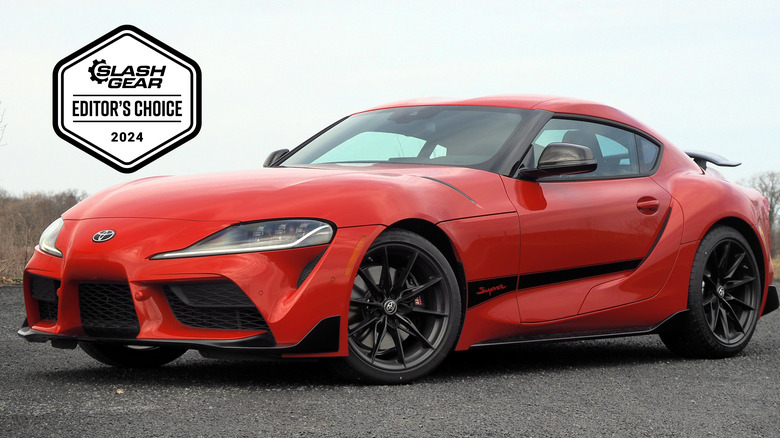
Chris Davies/SlashGear
EDITORS’ RATING : 9 / 10
- Affordable entertainment
- Head-turning style
- Manual transmission is a gem
- Surprisingly practical
- Infotainment display feels miserly
- Cabin isn’t small but getting out of it is a chore
You don’t need to look far through the automotive history books to figure out one of the winning recipes for sports car fun. A reasonably-powerful engine — preferably high-revving and with a sweet exhaust note — driving the rear wheels, with a stick shift for maximum driver engagement, all wrapped up in an eye-catching body with a reasonably-attainable price tag attached. Well, it took Toyota a little longer than expected to nail just that, but the 2024 GR Supra seems to fit the bill.
Back when it launched in 2019, the fifth-generation coupe almost got the mix just right. Sure, it wasn’t entirely Toyota’s handiwork — a cost-saving collaboration, instead, with BMW — but the new GR Supra was relatively affordable, amply powered, and certainly not attention-shy. Only the transmission failed to entirely satisfy, and now Toyota (and, for that matter, BMW with the manual Z4) has addressed that too.
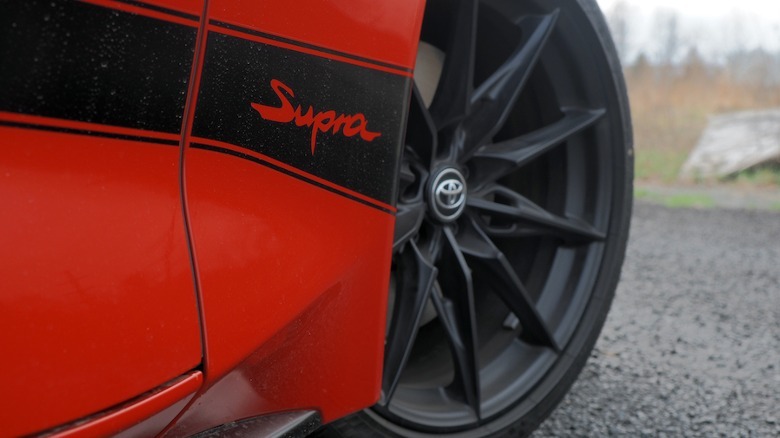
For the 2024 model year, the GR Supra kicks off at $46,440 (plus $1,095 destination). That gets you the base 2.0-liter engine. Stepping up to the Supra 3.0 — with the option of a stick shift transmission — starts at $54,400, or $58,550 (both plus destination) for the better-equipped 3.0 Premium trim. Though the limited-edition Supra A91-MT which debuted the manual is no more, there’s a 45th Anniversary Edition of which only 900 will be made. Based on the 3.0 Premium, it starts at $65,275 (plus destination).
Still striking, five years on
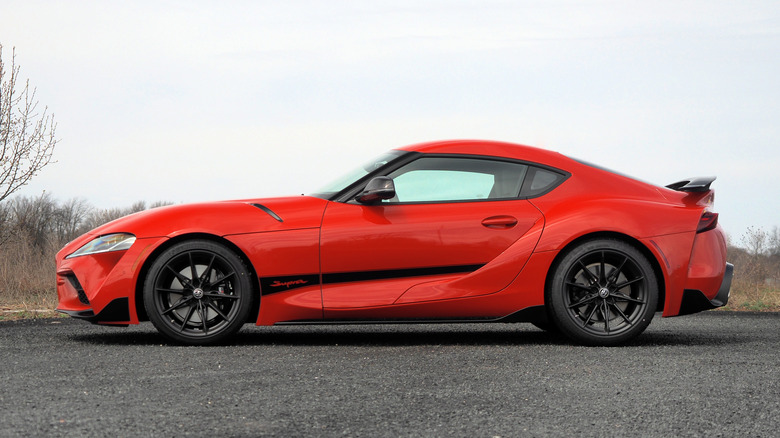
Chris Davies/SlashGear
Time dulls controversy, and what once seemed outlandish to the point of potentially deal-breaking about the Supra’s design is — five years after we first drove it — no longer so shocking. Toyota’s aesthetic still works best in profile, I think. The priapic hood, swept-back cabin, and cheeky upturned tail prove to be a delicious combination. Looking at it from the side also spares you from the weird little nose lump, which I’ve never warmed to.
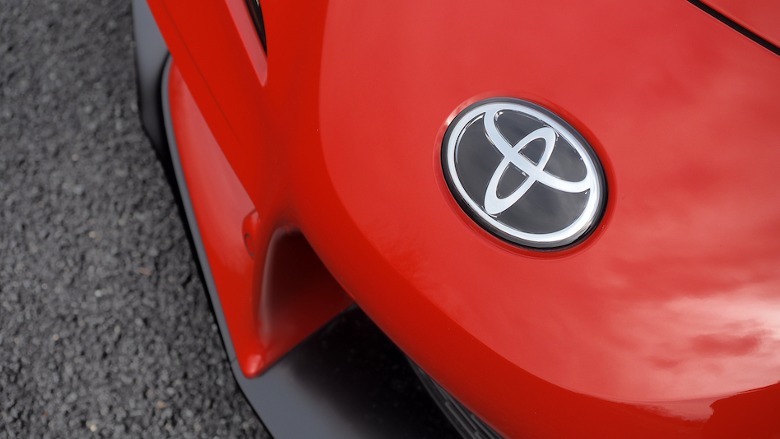
The rear, in the case of this 45th Anniversary Edition, gets a black manually adjustable spoiler which looks great and visually balances the chunky lower valance, even if it also cuts visibility through the back glass in half. 19-inch matte black wheels and a black «Supra» side graphic land on the tasteful side, too.
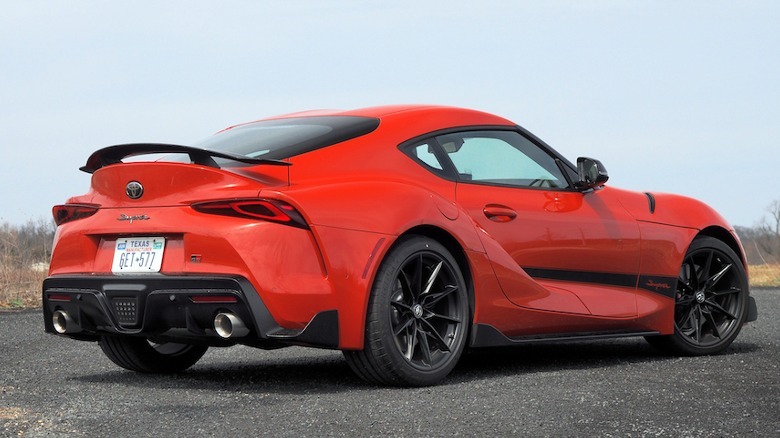
The Mikan Blast orange paint is also exclusive to the 45th Anniversary Edition car, though there’s an Absolute Zero silvery-white alternative if you’re a little more shy. Regular series Supra comes in a choice of white, red, blue, and black finishes. Not exactly dull, no, but it’s hard not to gaze with envy at the glorious Thundernight metallic purple that BMW offers on the Supra’s Z4 cousin.
If you want the stick shift, you have to buy the 3.0
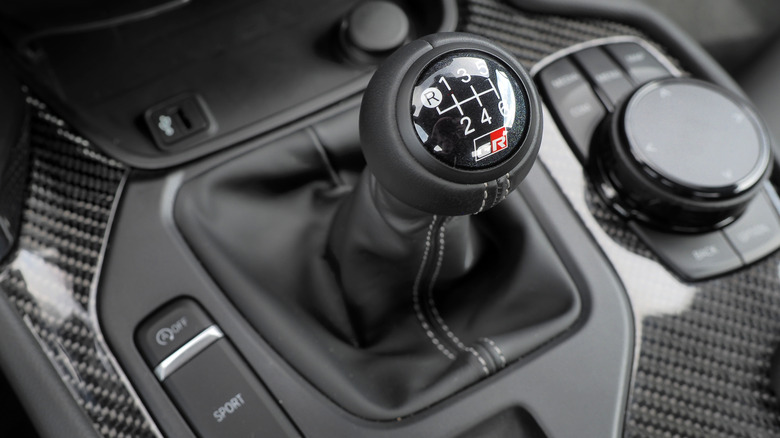
Chris Davies/SlashGear
Toyota offers two engines for the Supra. The base 2.0-liter turbocharged inline-four pipes 255 horsepower and 295 lb-ft of torque to the rear wheels, via a standard eight-speed automatic transmission. That’s good for a quoted 0-60 mph time of 5.0 seconds.
The Supra 3.0 — which this particular special edition is based upon — gets the 3.0-liter turbocharged inline-six like in the BMW Z4 M40i, nudging the figures up to 382 horsepower and 368 lb-ft of torque. You can have the same eight-speed auto with paddle shifters or, for no extra cost, a six-speed manual transmission.
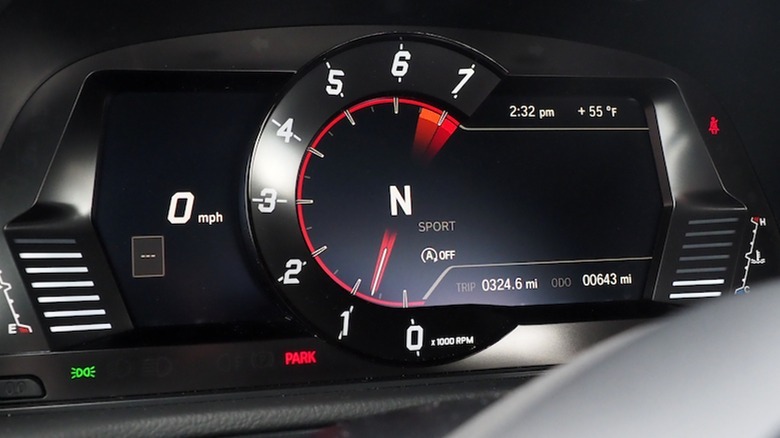
As has been the case for some time, now, the manual Supra is slower than its automatic sibling. We’re far beyond the days when a keen human driver could out-shift a laggardly old automatic. If you want the fastest 0-60 mph times, you’ll want the Supra with its 8-speed auto: it’ll do that dash in 3.9 seconds, Toyota claims, versus the 4.2 seconds of the stick.
Treat your feet to a third pedal
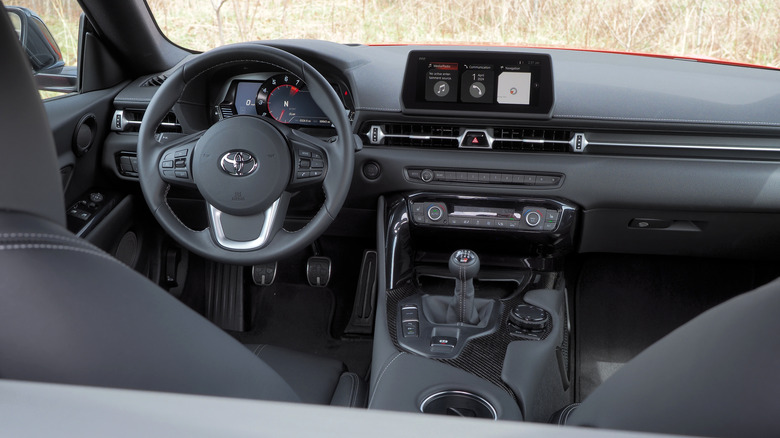
Chris Davies/SlashGear
On paper, that makes perfect sense. Out on the road, though, the (increasingly unusual) charm of rowing your own gears feels more persuasive than shaving a couple tenths of a second from a drag race run does. Toyota’s six-speed has a pleasingly short throw, the clutch is nicely weighted, and while you can snap off rapid shifts when the mood so takes you, it’s not so aggressive as to be a chore in regular driving.
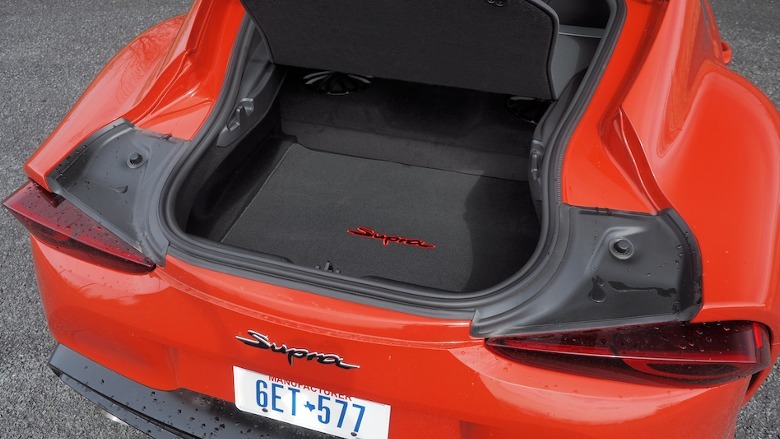
That last part is key, I suspect. The GR Supra — two-seater cabin, low ride height, and attention-seeking design aside — is surprisingly usable as a daily driver. Even the trunk offers a far-from-dire 10.2 cu-ft capacity. The only thing missing, to my mind, is automatic brake-hold; that’d make life easier at stop signs and lights, though the e-brake switch is readily placed for doing so manually.
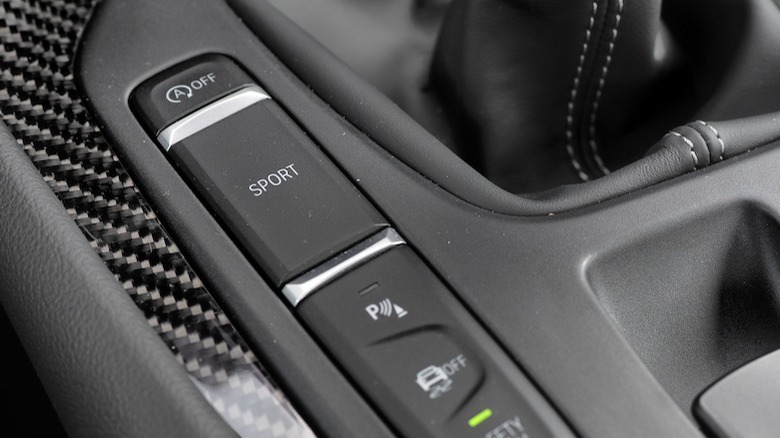
Something a lot of automakers could do worse than steal from Toyota is the GR Supra’s single «Sport» mode button. No complicated menus, no individually setting up the suspension, engine, exhaust, and everything else, as if you’re at the helm of the Space Shuttle. Just one stab at a decently-sized control and things wake up nicely, with a second button to shut off the traction control.
Tail-wagging good fun
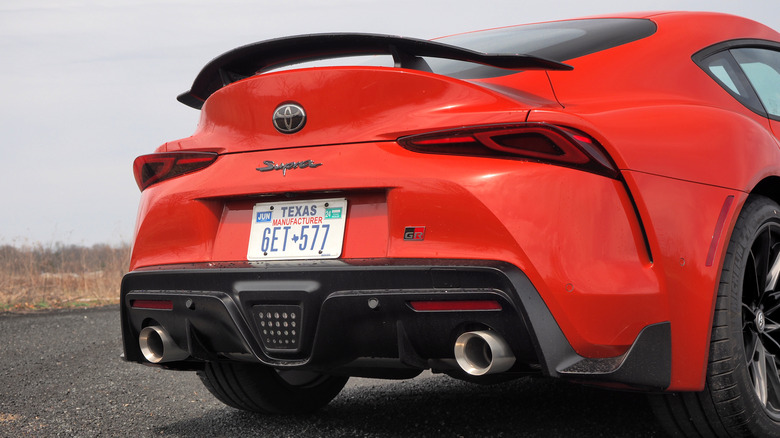
Chris Davies/SlashGear
Make no mistake, the GR Supra is a hoot. The automatic version is plenty of fun, no arguments there, but the ZF-sourced stick delivers a winning blend of driving involvement with electronic niceties like automatic rev-matching. And, with the inline-six’s peak horsepower not arriving until 5,800 rpm, there’s solid motivation for letting the engine yowl and the active exhaust system unlock its most rabid barks and gurgles.
More power isn’t the only reason to go for the bigger engine. Only the 3.0-liter Supra gets an active rear sport differential and an adaptive variable sport suspension system, for instance. There’s also a braking upgrade: 4-piston Brembo fixed-caliper disc brakes on the front, versus the Supra 2.0’s single-piston versions. The more potent car gets bigger, thicker rotors, too.
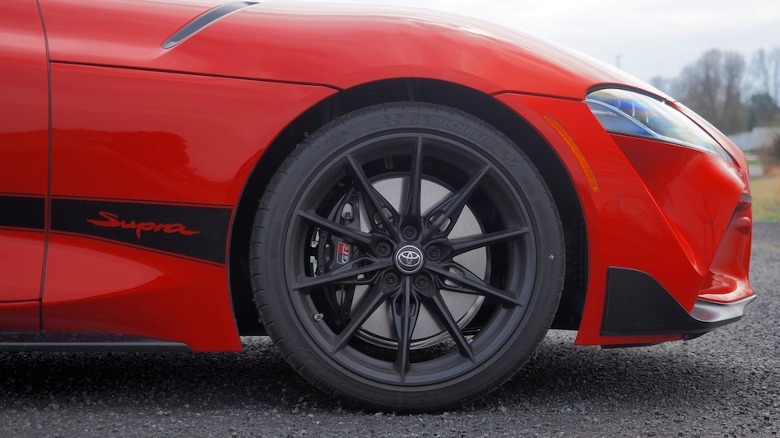
Even with the adaptive suspension, the Supra is no softy. Nor would you really want it to be, and even with the addition of the rear differential it can be a tail-happy thing. Loose gravel, a smudge of rain or snow, or even just an over-exuberant yank of the wheel is enough to get the rear end wagging, though it’s equally straightforward to bring back into line.
The BMW Z4 has a cabin edge
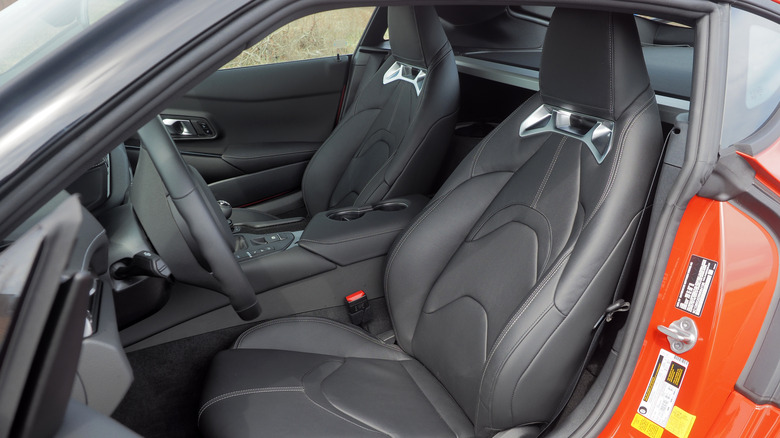
Chris Davies/SlashGear
The snazzy purple paint isn’t the only reason GR Supra buyers may be found looking enviously over at their Z4 counterparts. The Toyota uses BMW’s infotainment system — rebadged but otherwise instantly recognizable — but its 8.8 inch central display is markedly smaller than the 10.2 inch version in the Z4. There is, at least, wireless Apple CarPlay support, though some of the on-screen graphics are left on the diminutive side.
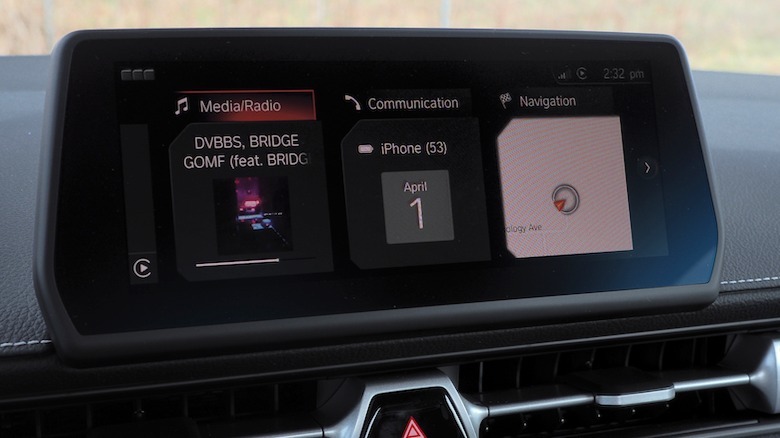
It’s not the only interface oddity, either: dual-zone climate control is standard on all GR Supra models, but there’s no sync button to adjust temperature on both sides of the cabin simultaneously. Putting anything in the cupholders then gets in the way of your elbow as you shift, and though at 5’8 I had no issues with headroom, making a graceful exit when the seat was at a comfortable position proved to be a work-in-progress.
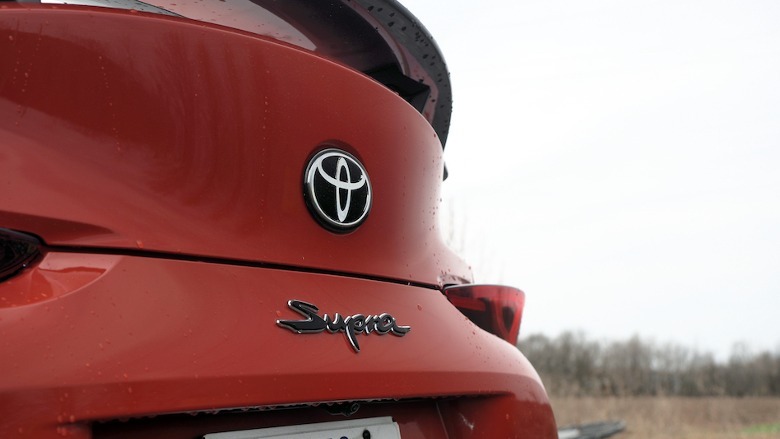
Fuel economy is another consideration. The Supra 2.0 is, unsurprisingly, the most frugal, rated at 25 mpg in the city, 31 mpg on the highway, and 25 mpg combined. That said, the automatic Supra 3.0 matches it on the highway and is only 2 mpg lower in the city, for a combined rating of 23 mpg. That leaves the manual Supra 3.0 lagging well behind, at 19 mpg city, 27 mpg highway, and 21 mpg combined, though driving with restraint means those numbers are eminently achievable.
2024 Toyota GR Supra 3.0 Verdict
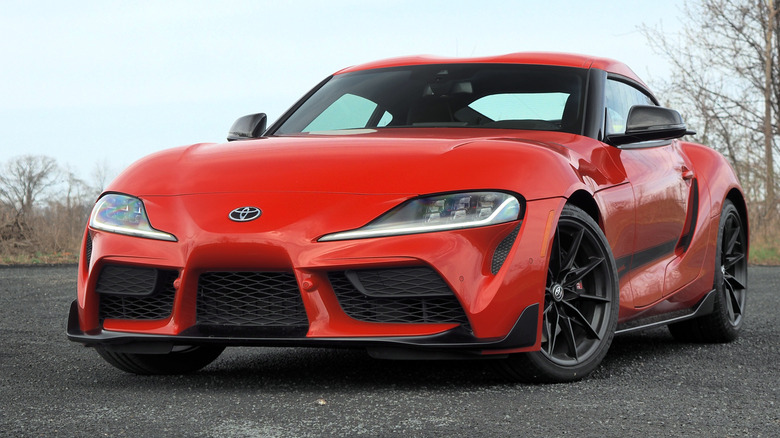
Chris Davies/SlashGear
If you care so much about fuel economy, though, perhaps you would be happier in a Prius (itself no bad thing, given how capable the latest generation of Toyota’s hybrid is). Embracing the sports car life means accepting that you’ll be paying more for gas, insurance, and probably tires too. The implicit payoff is that you’ll spend more of your time grinning as a result.
There, the 2024 GR Supra 3.0 delivers, and the manual even more so. We can argue aesthetics, but it’s tough to disagree with the combination of usability and playfulness that’s on offer here, especially for those bemoaning the dwindling number of stick shift options in the U.S. market.
Personally, I’d skip the 45th Anniversary Edition — its $65,470 all-in price tag brings you within spitting distance of coupe luminaries like the more potent Chevrolet Corvette, or the more prestigious Porsche 718 Cayman — and be satisfied with the standard 2024 GR Supra 3.0 manual. That, at $55,495 including destination, feels like a bonafide bargain.